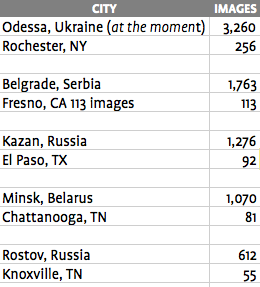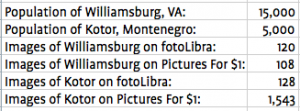Amazon Patents The Photographic Studio
May 12th, 2014by Gwyn Headley
Managing Director
Let’s get this straight — I love America. It’s a great place; brash, confident, a can-do country. If a British business fails, the humiliation and disgrace is a permanent stain. If an American business fails, they pick themselves up, dust themselves down, and start all over again. And some of my best friends are Americans, as you’d expect me to say.
In fact it was my American friend Martha Moran who alerted me to this extraordinary story, an unprecedented combination (to my mind) of ignorance, hubris, licit connivance and venality.
Photographer Udi Tirosh posted this blog. It describes how the US Patent & Trademark Office has awarded a patent to Amazon for photographing things against a white background. That’s right — a patent on what we call cut-outs. The imagery that made Dorling Kindersley books famous around the world.
How can they get away with this? What effect will it have? The darker side of American business confidence also lies in this “let’s try it on” attitude. And all too often the American establishment colludes.
There’s much not to like about America. Deranged gun laws. The Albuquerque Police Department, who have shot dead 55 people since 2010. The US legal system. The $67 million claimed by a judge for a lost pair of trousers. Companies who attempt to copyright phrases in the English language. Bridgeman Art Library‘s case against Corel for nicking their images — Bridgeman was British, Corel won. The publishers of He’s So Fine sued George Harrison‘s Harrisongs for plagiarism with My Sweet Lord, which had one chord change in common. Harrison lost. The catastrophic Gulf oil spill caused by an American subsidiary of the British firm BP — BP was given a swingeing, humungous fine and ordered to pay billions of dollars of compensation, sometimes to people living a couple of hundred miles inland.
Every man, woman and child in the United Kingdom spends £70 a year with Amazon. It provides an amazing selection and a terrific service. Of course we buy from Amazon SARL in Luxembourg, not from Amazon.co.uk, which merely takes our order in the UK, locates the product in the UK and posts it out to us in the UK from within the UK.
In the past three years Amazon has generated sales of more than £7.6 billion in the UK, without paying any corporation tax on the profits from those sales. They paid just £4.2 million in tax in 2013, 0.1% of their UK revenues.
And you know why? Because their tax advisors are smarter than our taxmen and our government. Amazon is doing nothing wrong. We are missing out because of the incompetence of our legislators and HMRC.
And can Dorling Kindersley now expect Amazon to come knocking?
Exposure Doesn’t Pay The Bills
May 7th, 2014by Gwyn Headley
Managing Director
Tags: bills, charity, Enzo Dal Verme, exposure, fees, free, payment, Philip Enticknap, publicity
Ace picture librarian Philip Enticknap (now retired, luckily for us) posted a link on the Picture Editors & Researchers group on LinkedIn to a short video made by Italian photographer Enzo Dal Verme. It’s a quiet, gentle way of dealing with a situation we often address in the fotoLibra Pro Blog — the inability of some people to realise that photographs cost money, and photographers need to be paid.
Dal Verme’s blog appears to be offline at the moment, so I hope it helps if I post his video here. It’s been going the rounds for the past two years, but I hadn’t seen it before. It’s well worth watching. Thanks for finding it, Philip.
I can’t let a link go by without clicking it, so I discovered that Enzo acquired his unusual surname because an ancestor of his killed a dragon that had been terrorizing the inhabitants of Verona. Hence he was named Dal Verme — The Worm. Cf the Lambton Worm in Durham, a dragon killed by an ancestor of the photographer Lucinda Lambton.
Worms, dragons and photographers. There’s a combination.
The Worm Glances Back*
May 2nd, 2014In March we were contacted by a picture buyer who was working on a set of booklets for a health clinic. She wanted 100 pictures of various foods and people. The pictures were to be used on company brochures, their website and information booklets. She said her budget was €100, and would we like to offer her a price?
“Is that your budget per image?” enquired Yvonne innocently.
The buyer responded “You can’t be serious — April 1st is next month. I think the megabuck days are over. We have a US site giving us the deal for $175.”
So we lost the job and suffered a little humiliation into the bargain.
But is she right? Are the megabuck days over?
Yes, if there ever were megabuck days. We never experienced them.
Before digital replaced film — perhaps the most crushing disruption ever experienced by any peacetime industry — buyers would spend £1,000 on a front cover image. As regular readers will know, I am no photographer, but a magazine paid me £1,600 for four of my distinctly average photographs in the ’90s — for the simple reason that they couldn’t find them anywhere else.
That’s what all picture libraries want to be able to to do — supply images that can’t be found anywhere else.
But that’s not always what the market wants or needs. Like most markets, the lowest common denominator is king. If you’re selling insurance, houses or holidays to the over-60s, then you have to use a photograph of a smiling, handsome, healthy grey-haired couple. I believe it’s enshrined in American law.
As a result microstock sites are awash with such images: happy couples running hand-in-hand through the surf, a phalanx of ethnically correct young executives smiling at the camera. They sell over and over again. But if you need a picture of the ruins of St Peter’s Seminary, Cardross, then your average microstock agency ain’t gonna help.
The difficulty is that buyers have rapidly become accustomed to paying a dollar for any picture, so when we try to charge real money for a real image, they throw their hands up in horror. My dream conversation:
THEY: “£100? You’re havin’ a laugh. I buy me photos from fotoLia for a dollar each.”
WE: “Then may I suggest, Sir, that you purchase said image from the establishment wot you mentioned.”
THEY: “But they haven’t got one.”
WE: “That’ll be £100 then please sir, ay theng yow.”
It doesn’t often happen. Shame.
But yesterday we heard news of a fightback by photographers. fotoLia is a microstock agency with a name suspiciously reminiscent of a longer-established company (called fotoLibra). It has millions of royalty-free images, and it recently launched a new initiative called The Dollar Photo Club, where they sell ten images for $10 (it works out at $10 for the image you actually want, and they throw in nine more).
This has proved one step too far for some people. A group has been set up by Olga Kostenko, a Ukrainian photographer (I’m amazed she has the time at the moment) called Boycott fotoLia.
It first appeared in the Stock Photography Buy and Sell Images group on LinkedIn, but mysteriously it has now been taken down. Nevertheless their English language website is still active, and as of today it claimed that 432,563 images had been removed from fotoLia in the past week, and 176 photographers had removed their entire portfolios. It’s a drop in the ocean for fotoLia, but the worm, if not actually turning, is at least glancing back.
Kostenko writes: It is clear that the final target of Fotolia owners is not a new market but a takeover of the current stock market. Fotolia management tries to convince us that they are care about us, the content creators. They tell us that it is profitable not only for Dollar Photo Club and Fotolia. They tell us that it is profitable for authors as well. But it is not. DPC incomes will grow by pulling existing buyers away from other stock agencies, not by finding new buyers. DPC’s goal is get a big bite of the stock pie, cut out this market, move to a completely new arrangement with buyers and crush its competitors. And all of this is done with our unconditional support. Because at this moment we don’t have rights. We cannot refuse to allow our images to be used on DPC. All our images from Fotolia are on DPC as well. We don’t have the choice to add or delete our images from DPC.
FotoLia responded to Will Carleton’s Photo Archive News, and you can read their reply here.
If you are a contributor to fotoLia, are you happy with this development?
Have you removed your images?
*prior to The Worm Turning?
Bada Bing!
April 4th, 2014by Gwyn Headley
Managing Director
As an Apple user of 23 years’ standing, I obviously prefer to use the Bing search engine from Microsoft rather than any goggle-eyed alternative. It has a very rigorous porn filter, so when I search for Gwyn Headley (come on! don’t we all?) I get 31,000 results as opposed to 64,000 from a rival search engine.
But the main reason I like to use Bing is that it looks so nice. And one of the reasons it looks so nice it because they buy photographs from fotoLibra to use on their home page. Here are two fotoLibra images they’ve recently chosen:
Congratulations to fotoLibra contributors Linda Wright and Paul Benson.
And what’s more, Bing pays decently as well. Full marks.
The BAPLA Quiz
March 20th, 2014by Gwyn Headley
Managing Director
Tags: ach-y-fi, ambrosia, Arcadia, bacchanalia, BAPLA Quiz, Beverley Ballard, British Library, Camera Press, Charlotte Lippmann, Damien Gaillard, fotoLibra, Four Corners Images, goddesses, gods, Gwyn Headley, hoi polloi, ivory towers, Martyn Goddard, Mary Evans, National Portrait Gallery, nectar, nymphs, Offside Sports Images, picture library, satyrs, Steve Lake, stock agency, Superstock, sylvan glades, The Bridgman Art Library, Yvonne Seeley
Life working in a picture library isn’t just wine and roses, you know. There’s only so much disporting ourselves in sylvan glades we can get through in a day, and there can be such a thing as a surfeit of ambrosia and an excess of nectar. From time to time we are forced to descend from our ivory citadels and face the gritty reality of everyday life, away from our cloistered, chauffeured and charmed lives, and deal with Ordinary People, who have to get by on Wine. And Beer. Occasionally we even have to confront what we believe is called Hard Work.
Such a day came yesterday evening, in the guise of the BAPLA (British Association of Picture Libraries & Agencies) Quiz. Goodness, we had to work! It was so-o-o Hard! A nasty man kept asking us difficult questions — a proper interrogation it was — and he ignored me when I plaintively demanded more nectar and ambrosia, making me drink Beer and Wine instead, and asking me more hard questions. I won’t be doing that again in a hurry.
From a human PoV this event was much like a pub quiz, except the participants were all picture libraries and picture researchers; the nymphs, satyrs, gods and goddesses of the image world. We congregated at the Yorkshire Grey in Theobalds Road, hard by Gray’s Inn in the centre of London, on Earth.
All the teams had exotic names, coincidentally mirroring the names we use back home in Arcadia.
Graham, Llinos and Jacqui couldn’t be coaxed from their dreaming spires, so the fotoLibra team consisted of:
- Charlotte Lippmann, Picture Researcher
- Beverley Ballard, Picture Researcher
- Martyn Goddard, Photographer
- Damien Gaillard, fL Technical Development Manager
- Yvonne Seeley, fL Marketing Director, and
- Gwyn Headley (that’s me), fl MD.
Each team had to have a minimum of two picture researchers, and so we are very grateful to Beverley and Charlotte for putting up with us.
The questions were compiled and enforced by Steve Lake of 4 Corners Images, and he was merciless. No, implacable. No, unrelenting. Yes, all three, and more.
For example, we were shown Photos of Celebs When Young. We got 3 out of 20 right. Who on earth knew that José Mourinho used to have horns?
Then followed questions of every sort, such as “What does the term Lyonnaise mean when applied to French cooking?”
We had a secret weapon here. Damien, our TDM, is from Lyons, and his brother is a top chef in Paris. So “Potatoes,” I said decisively. “Cream,” said Bev. Nothing, said Damien. We left it blank.
The answer was Onions. “Onions? Everything in France has onions!” complained Martyn.
Finally the results came in. There were tears. There was laughter. There was gross injustice. To show how remorseless Question Master Steve was, he slashed 20 points from the British Library for writing ‘Euston Square’ instead of ‘Euston Road’ .
fotoLibra only came fourth, despite our clear superiority. We would have won by a large margin if the other teams hadn’t known more than us. Not fair.
The official results (subject to scrutineering) were
- The Bridgman Art Library
- Mary Evans
- Offside Sports Images
- fotoLibra
- Camera Press
- National Portrait Gallery
- British Library
- Superstock
So here we are this morning, back in our ivory tower, re-insulated from the οἱ ολλοί, gazing out at the world (ach-y-fi! nasty, dirty place!) and I’m contemplating a quiet bacchanalia or two to restore my flagging spirits.
Ah! Here comes Pan! I’ll have to go — gotta dance, gotta sing. See you later!
This is posted in an effort to placate Owen Elias, who wrote about my last blog “Another moaning tirade. Do you never have anything positive to say?”
The Russians Are Coming!
March 12th, 2014by Gwyn Headley
Managing Director
Tags: $1, 25 million, Belgrade, Chattanooga, dollar, El Paso, fotoLibra, Fresno, images, Kazan, Knoxville, Kotor, Minsk, Montenegro, Odessa, picture library, pictures for a dollar, Rochester, Rostov, Russians, stock agency, Williamsburg
25 million images for a dollar each!
Yet another ‘stock agency’ has bulk-emailed the world (why should spam trouble them?) to tell us we can buy images from them for a dollar each.
Of course you can’t actually buy a picture from them for a dollar, despite what they promise. You have to start by paying a minimum of ten dollars, at which point they’ll throw in nine extra pictures (which you may or may not want) for free.
The pound, the euro, the yen and the rouble don’t concern them; they only want your dollars.
The business model is to blind buyers with price and quantity, and gloss over content and quality. Pile ’em high, sell ’em cheap. It’s a well-used model.
But talking of content and quality, the balance of image subjects seems wrong for a website which appears to be US-based and aimed primarily at American buyers. Compare these eastern and western cities, all with populations around the million mark. Here are the number of images Pictures For A Dollar (not its real name, natch) has of each location:
As for my headline, I have no idea if this site has anything to do with our Russian friends. But there does seem to be a definite Eastern flavour to the content. As the table above demonstrates, there are ten times as many images of former Soviet bloc cities than of American cities. Which is very useful if you are publishing to the Eastern European market.
Check out these two tourist destinations:
Where did this Pictures For A Dollar site acquire its images, do you think? From all the figures quoted, it certainly looks more Eastern than Western.
I assume they own all these images, so they don’t have to pay the photographers. Therefore all the business costs are pumped into marketing the static stock. There is no indication that there will be new additions to the 25 million images they hold — the website baldly states “Pictures For A Dollar is not accepting contributors at this time.”
Why does this upset me? Because this has nothing to do with photography. Photographers are not welcome on this site.
This is a commodity sale, which will directly affect the livelihood of yet more photographers. I very much doubt that the photographers who supplied the majority of images which ended up on Pictures For A Dollar are going to see a cent for their work. And I don’t think that’s fair.
What worries me is how can a picture library (British usage) or stock agency (American usage) like fotoLibra compete?
I hope it will be by providing well-keyworded, precise, high-quality, up-to-date AND historical images that people actually want and need, not a dubious flytip of cheaply acquired bulk collections that might pass at a pinch.
Or do you have other ideas?
Why do stock photos look like stock photos?
February 28th, 2014by Gwyn Headley
Managing Director
Quora is an interesting web site. Questions are created, answered, edited and organized by its users. And its users seem more intelligent and less abusive than the average troll one encounters online.
Here’s a good one: What are some of the reasons that stock photos look like stock photos?
This is an excellent question. Alas, so far there are only four answers, none of them particularly illuminating.
Let me have a go. First of all, let’s forget photography and look at economics — the law of supply and demand. The four basic laws of supply and demand are:
- Demand increases, supply remains unchanged: a shortage occurs, leading to a higher equilibrium price.
- Demand decreases, supply remains unchanged: a surplus occurs, leading to a lower equilibrium price.
- Demand remains unchanged, supply increases: a surplus occurs, leading to a lower equilibrium price.
- Demand remains unchanged, supply decreases: a shortage occurs, leading to a higher equilibrium price.
Unfortunately in the picture library / stock agency business we have involuntarily created the fifth law of supply and demand:
- Demand decreases, supply increases dramatically: a massive surplus occurs, leading to a far lower equilibrium price.
That’s where we stand at the moment. Twenty years ago if you wanted a sunny photograph of a couple running happily down a beach hand-in-hand, you either commissioned a photographer at considerable expense, or you trawled through transparencies at a picture library (and paid a hefty fee for doing so). Now they’re so common you can scarcely give them away.
I went into the Spar store in Harlech yesterday, hoping to buy a packet of frozen broad beans. What they had in the freezer was:
- Frozen oven chips
- Frozen roast potatoes
- Frozen potato wedges
- Frozen hash browns
- Frozen French fries
- Frozen jacket potatoes
- Frozen Smiles (??) potatoes
- Frozen garden peas
That was the extent of their frozen vegetable range. Now I’m as anti-eating green things as any ordinary man can be (although peas and broad beans are sort of OK) but even I felt that this was an overwhelming bias in favour of potato-based products.
Potato-based products are heavily marketed, so people buy them. At first we don’t notice the broad bean chicks have been ousted from the freezer nest by these cuckoo brands.
It’s the same with microstock and rights-managed images. Microstock is heavily marketed, like supermarkets, with a loss leader — $1 for an image! And that’s all that buyers remember, until they’re suckered in to an annual deal where they’ll pay as much for their images as if they’d bought them from us without any trade agreement. They don’t notice they end up paying at least the same, and probably more.
The boon and the benefit of Microstock is that everything has been ironed down to the lowest possible common denominator. Welcome to a perfect world, where everyone lives exclusively on potato-based products and sugary drinks, yet keeps a trim figure and teeth like the grille on a Cadillac. Nothing has ever gone wrong in these people’s lives, and that’s what the client wants. So endless numbers of photographers endlessly reproduce the same image with infinitesmal variations, like this:
Oops — the last one is embarrassingly much better then the rest. Oh, it’s not a microstock image at all, it’s a fotoLibra Rights Managed image (thank you, Peter Phipp!).
When I was a kid we rebelled against conformity by growing long hair and wearing blue jeans. We all wanted long hair and blue jeans. We all looked the same. We conformed.
The point is that stock photos look like stock photos because that’s what the market wants. Conformity. And potato-based products.
You get what you pay for.
Wedding Cake Blues
February 10th, 2014by Gwyn Headley
Managing Director
Until fotoLibra Version 6.0 was launched in December our site didn’t actually say that we sold images — we just assumed that people would know.
It seems not everyone understands. In November we sold usage rights in a photograph of a wedding cake decorative topper — Personal Use (One-Off) — to a lady in the mid-Western United States.
Last week we had a querulous email from her. “I ordered and paid for a wedding cake decorative topper last November, and I still haven’t received it.”
We looked at each other in horror (although I could barely suppress a grin). She had bought image usage rights when she thought she was buying an actual item. I was flooded with pity, because I could put myself right in her place. I knew just how she was feeling.
But we’d already paid the photographer for the sale. We could hardly ask him to give the money back. So we tactfully explained the situation to her, that we were a picture library (US = Stock Agency) and not a fancy goods retailer, that it was clearly pointed out on the website, and that she now had the right to get this picture printed out as a huge poster and stuck on her wall. She accepted the situation.
We get regular calls from gentlemen with thick, impenetrable accents who are interested in the derelict petrol stations you can see on fotoLibra. They’re not interested in images of them — they want the actual sites, and they rumble threateningly when we try to explain we only sell pictures of the sites.
The nadir was reached when one man rang up to order some bollards. Once again we patiently tried to explain we sold images of bollards, not actual bollards. The enquirer was an Englishman, with a fluent and rapid command of the language, albeit with an extremely limited vocabulary. He informed us at length (in Neville Shute’s terminology) that we were Fugging Muggers and also, weirdly, Bunts. The invective was foul, sustained, vicious and a total waste of time. God knows what he was planning to do with the bollards once he got hold of them. We had a satisfying, if impractical, suggestion for him.
I’m really very sorry for the Mid-Western US lady and her wedding cake decorative topper. But we shouldn’t have to pay for other people’s mistakes, even a small amount. And after Chris Holifield of the Writer’s Services website pointed out that we didn’t say what we did, we rectified it. Now fotoLibra.com introduces itself with HOW TO BUY IMAGES | HOW TO SELL IMAGES.
No more confusion then. Thank you, Chris!
So This Is What We’re For
January 8th, 2014by Gwyn Headley
Managing Director
We received a cheery sales enquiry this morning:
Good morning,
I work for the Social Security Administration (SSA) in the Dallas Region. The Dallas Region is comprised of Social Security offices in 5 states (New Mexico, Oklahoma, Texas, Louisiana and Arkansas). The Dallas Region is separated into 6 parts called Area’s [I think he means Areas]. One such Area has Social Security Offices in two states (Oklahoma and Arkansas).
We are creating a banner for the Area front page that would represent 2 states (Oklahoma and Arkansas) and we would like to use one of your pictures as part of the banner to represent the State of Arkansas. This front page would exist on a Secure intranet and would only be visible to Social Security employees. This Intranet is not accessible to the general public or anyone outside of the Social Security Administration and serves as an information portal for SSA employees.
Please consider allowing us to use your image shown. As a government entity we cannot pay for rights.
Yvonne was on it in a flash:
Hello Tony
Many thanks for your message and for your interest in one of our images. I’m sorry to read that as a government entity you can’t pay for rights because, as a stock agency, our business is selling usage rights for our many contributors.
I regret that I can see no reason why we should give you free rights to use one of our images and wish you luck in persuading someone else to give away their work for no reward.
Regards,
Yvonne Seeley
What a model of restraint. It’s fortunate she responded before I had a chance to vent my spleen, otherwise Anglo-American relationships could have been irreparably damaged.
This scenario is becoming increasingly common. I wrote about it in a blog last November, Give Us Your Work For Free. Yvonne was more concise and to the point than Whitey. Why should anybody, in any organisation, in any country, anywhere in the world, expect to be paid for what they do and yet expect you and me to hand over the fruits of our investment, creativity and labour for nothing? It’s contemptuous, patronising and demeaning.
Mind you, Yvonne has form where this sort of behaviour is concerned. Some years ago when she was working for BASF and Sir Peter Hall was Director of the National Theatre, Hall’s secretary rang up to order 10 reels of recording tape. Yvonne’s question was to be expected: “To whom shall I send the invoice?” In a flash Hall (as he was then) was on the phone, fulminating “Don’t you know who I am? I’ll have your job for this!” Yvonne answered evenly, “I don’t think so. Now do you want to buy these tapes or not?”
Collapse of stout party, as they say.
Only one good comes of this. It shows that a picture library set up in a remote corner of North-West Wales can be seen and used by a US government department.
The next step is to get them to pay $600 for our lavatory seat. Older readers will recall the reference.








